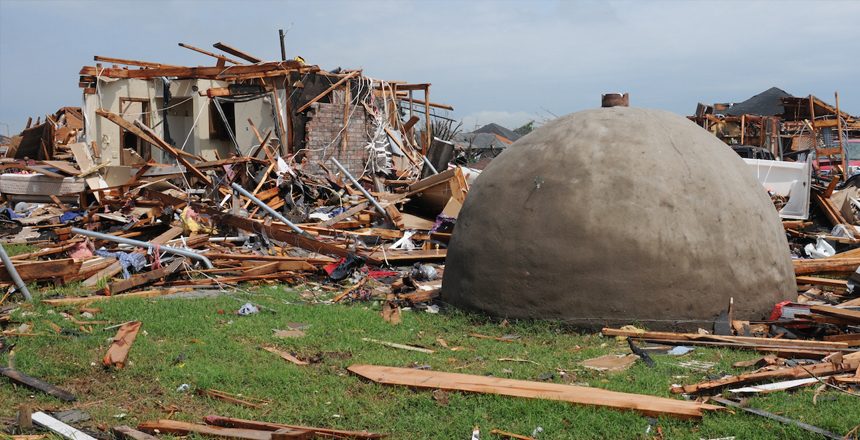July is National Disaster Education Month, and it’s a perfect month to learn more about natural disasters and how to prepare for them. In our home state of South Dakota, we’ve already seen record-setting straight line winds, torrential rains, and flash floods. But we want to focus on preparing for tornadoes, one of the most dangerous natural disasters nature can bring to the Great Plains.
What Is a Tornado?
When high pressure and low-pressure weather systems collide, like cold and warm fronts, thunderstorms can develop bringing hail, lightning, heavy rain, and powerful winds. These conditions alone can cause major damage to trees, buildings, and vehicles.
When the conditions are right, these thunderstorms can also produce funnel clouds. And with enough energy from the storm line, these spinning masses of clouds can push down to create tornadoes. These fast-moving vortices can range from a dozen yards to more than a mile in width, and they can create damage paths that destroy nearly anything in their way.
Tornadoes are categorized on a scale similar to tropical storms and hurricanes. This scale, known as the Enhanced Fujita Scale (Enhanced F-Scale), is based on wind speeds within the tornado itself, which can be either radar-indicated or measured by devices on the ground near or in the tornado. Starting at an EF-0, with wind speeds from 65mph to 110mph, the scale extends to tornadoes with winds upwards of 200mph (an EF-5 rating). While most tornadoes don’t grow past the EF-2 rating, even these storms can cause significant damage to structures.
Preparing for Tornadoes and Severe Summer Storms
With the possibility of extensive property damage, preparing for a tornado (or any severe storm) should be a part of your family’s planning process. To make an emergency situation more manageable, there are certain things that you can prepare ahead of time to make sure your family is safe and secure in case of an emergency.
1 – Create a Plan
Your family should have a plan in place for emergency situations, including preparing for tornadoes and severe weather events. This plan should include a designated safe place, such as an interior room with no windows, or a below-grade room or space to shelter. Above-grade structures tend to suffer severe damage during tornadoes.
Preparing for tornadoes should also include planning out a route to the designated safe place. In an actual storm, it may be difficult to gather everyone quickly if your family hasn’t practiced the route. Talk about where to go, what to bring or not bring, and how to get there safely.
2 – Put Together an Emergency Kit
It’s easy to forget important items or miss essentials during an emergency, so having a kit ready to go will provide you with peace of mind. There are a few key items you need for safety during the tornado, as well as some items to help your family stay healthy and recover quickly after the storm. Here’s a basic storm preparedness kit you can have ready in your home:
- Blankets or sleeping bags for each person in your home
- Full change of clothes and sturdy shoes for each person
- A first aid kit, matches, and a pencil and paper in a waterproof container
- Flashlight and extra batteries, as well as a backup battery pack for cell phones
- Toiletries and medications for the family, both prescription and nonprescription, as well as personal hygiene products
- Diapers, formula, bottles, and baby wipes for infants
- Important documents, insurance information, and bank information, stored either electronically or in a waterproof container
3 – Stay Safe During the Tornado
Preparing for tornadoes or severe weather events also means making sure you know what to do to stay safe in your designated safe room. Make sure you have access to either an NOAA weather radio or have EAS alerts set up on your phone so you have up-to-date information on weather conditions both during and after a tornado. It’s also important to have blankets, pillows, or cushions available to cover your head, neck, and body for protection. Avoid windows and exterior walls when possible, as these structural features could collapse during a tornado.
If you are unable to get to a safe room or structure, never try to outrun a tornado. The storm can move faster than you realize, and the direction of the storm can change suddenly. Instead, find a location that offers sturdy cover overhead and a place where you can avoid debris.
A Safe Structure for Extreme Weather
Although a conventional home might have a somewhat safe place to take shelter, it’s not a guarantee of safety. Tornadoes are known to rip homes from their foundations and leave little intact. FEMA encourages building a certified safe room so that your family has the best chance possible of surviving a tornado or other major disaster. One such structure is a concrete dome home.
Concrete domes are FEMA-approved safe rooms, and they come with the title of near-complete protection from disasters, including tornadoes, wildfires, civil unrest, and floods. These fully customizable structures can also include safe rooms, bringing peace of mind to those in areas where tornadoes are frequent. They can also offer a place to store the necessary supplies to recover from major storms.
If this sounds like a solution you’d love to have for your family, we have you covered. Our concrete domes are fully customizable and can be made to meet any requirement. But concrete domes can be much more than just a safe space during emergencies. We can also build entire custom homes, climate-controlled storage facilities, and money-saving agricultural grain storage solutions. Schedule a tour of our own model dome home, or set up an appointment to start customizing your very own concrete dome via our website or by calling 605-368-5447.
*Photo source: Science.org (FEMA/George Armstrong)



